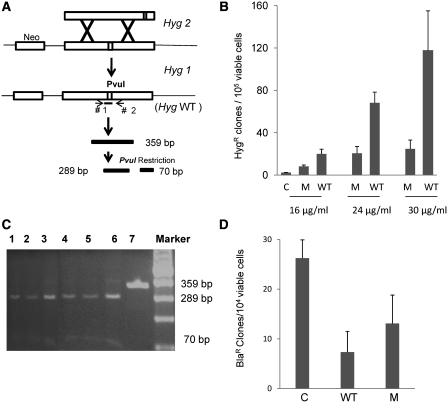Figure 3.
Effect of yRad52tat11 protein on GT and RI. (A) Measure of GT events between the single chromosomal HygR gene utilized in the experiments of Figure 2 (hyg1), and the BamHI fragment transfected by electroporation to the cells, corresponding to mutant hyg2 in the same figure; a GT event leads to the formation of wild-type HygR gene (Hyg WT) with the restoration of the restriction site PvuI. (B) GT experiment in HeLa1B cells carried out transfecting by electroporation 10 μg of BamHI hyg2 DNA fragment purified from agarose gel; cells were pre-incubated for 6 h with 16, 24 or 30 μg/ml yRad52tat11 or Y66A protein (M); GT frequency is expressed as total HygR clones per 105 viable cells and the results are the mean of at least three independent experiments ± standard deviation. (C) The 359 bp Hyg fragment was amplified by PCR from the genomic DNA of HygR clones and digested with PvuI; the digestion gave a 289- and a 70-bp fragment; lanes 1–6, DNA from HygR clones digested with PvuI; lane 7, not restricted DNA. (D) Effect of wild-type yRad52tat11 or Y66A protein (M) on random integration; the frequency of random integration was determined in HeLa1B cells by electroporating 8 µg of plasmid DNA and measured as number of total BlaR clones per 104 viable cells; the results are the mean of four independent experiments ± standard deviation.

